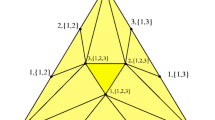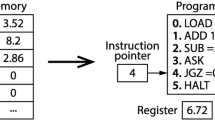Abstract
Look-Compute-Move models for a set of autonomous robots have been thoroughly studied for over two decades. We consider the standard Asynchronous Luminous Robots (ALR) model, where robots are located in a graph G. Each robot, repeatedly Looks at its surroundings and obtains a snapshot containing the vertices of G, where all robots are located; based on this snapshot, each robot Computes a vertex (adjacent to its current position), and then Moves to it. Robots have visible lights, allowing them to communicate more information than only its actual position, and they move asynchronously, meaning that each one runs at its own arbitrary speed. We are also interested in a case which has been barely explored: the robots need not all be present initially, they might appear asynchronously. We call this the Extended Asynchronous Appearing Luminous Robots (EALR) model. A central problem in the mobile robots area is bringing the robots to the same vertex. We study several versions of this problem, where the robots move towards the same (or close to each other) vertices. And we concentrate on the requirement that each robot executes a finite number of Look-Compute-Move cycles, independently of the interleaving of other robot’s cycles, and then stops. Our main result is direct connections between the (ALR and) EALR model and the asynchronous wait-free multiprocess read/write shared memory (WFSM) model. General robot tasks in a graph are also provided, which include several version of gathering. Finally, using the connection between the EALR model and the WFSM model, a combinatorial topology characterization for the solvable robot tasks is presented.



Similar content being viewed by others
Notes
Note that with this modification it is straightforward to model systems where all robots are initially visible since the beginning of the execution: the light of every robot is initialized merely to a non-negative value, for example, 0.
In the Strong version of the EARL, we assume that robots are non-oblivious, non-anonymous, non-disoriented, share the same labeling of G and can detect multiplicities.
References
Suzuki, I., Yamashita, M.: Distributed anonymous mobile robots: formation of geometric patterns. SIAM J. Comput. 28(4), 1347–1363 (1999)
Fischer, M.J., Lynch, N.A., Paterson, M.: Impossibility of distributed consensus with one faulty process. J. ACM 32(2), 374–382 (1985)
Herlihy, M., Kozlov, D., Rajsbaum, S.: Distributed Computing Through Combinatorial Topology. Morgan Kaufmann, San Francisco, CA (2013)
Flocchini, P., Prencipe, G., Santoro, N.: Distributed Computing by Oblivious Mobile Robots. Synthesis Lectures on Distributed Computing Theory, vol. 3(2). Morgan & Claypool, San Rafael (2012)
Flocchini, P., Prencipe, G., Santoro, N., Widmayer, P.: Hard Tasks for Weak Robots: The Role of Common Knowledge in Pattern Formation by Autonomous Mobile Robots, LNCS, vol. 1741, pp. 93–102. Springer, Berlin (1999)
Asaf, E., Peleg, D.: Distributed models and algorithms for mobile robot systems. In: 33rd Conference on Current Trends in Theory and Practice of Computer Science (SOFSEM), LNCS, vol. 4362, pp. 70–87. Springer (2007)
Das, S., Flocchini, P., Prencipe, G., Santoro, N., Yamashita, M.: Autonomous mobile robots with lights. Theor. Comput. Sci. 609(P1), 171–184 (2016)
D’Emidio, M., Frigioni, D., Navarra, A.: Synchronous robots vs asynchronous lights-enhanced robots on graphs. In: Electronic Notes in Theoretical Computer Science. Proceedings of ICTCS 2015, the 16th Italian Conference on Theoretical Computer Science, vol. 322, pp. 169–180 (2016)
Yu, X., Yung, M.: Agent rendezvous: a dynamic symmetry-breaking problem. In: Automata, Languages and Programming, 23rd International Colloquium, ICALP96, Paderborn, Germany, 8–12 July 1996, Proceedings, LNCS, vol. 1099, pp. 610–621. Springer (1996)
Potop-Butucaru, M., Raynal, M., Tixeuil, S.: Distributed computing with mobile robots: an introductory survey. In: 2011 14th International Conference on Network-Based Information Systems (NBiS), pp. 318–324 (2011)
Prencipe, G.: Autonomous mobile robots: a distributed computing perspective. In: 9th International Symposium on Algorithms and Experiments for Sensor Systems, Wireless Networks and Distributed Robotics (ALGOSENSORS), LNCS, vol. 8243, pp. 6–21. Springer (2014)
Prencipe, G.: Impossibility of gathering by a set of autonomous mobile robots. In: Theoretical Computer Science, Structural Information and Communication Complexity (SIROCCO 2005), vol. 384(2), pp. 222–231 (2007)
Cieliebak, M., Flocchini, P., Prencipe, G., Santoro, N.: Distributed computing by mobile robots: gathering. SIAM J. Comput. 41(4), 829–879 (2012)
Flocchini, P., Prencipe, G., Santoro, N., Widmayer, P.: Gathering of asynchronous robots with limited visibility. Theor. Comput. Sci. 337(1), 147–168 (2005)
Cieliebak, M.: Gathering non-oblivious mobile robots. In: Farach-Colton, M. (ed.) LATIN 2004: Theoretical Informatics, pp. 577–588. Springer, Berlin (2004)
Cohen, R., Peleg, D.: Convergence properties of the gravitational algorithm in asynchronous robot systems. SIAM J. Comput. 34(6), 1516–1528 (2005)
Klasing, R., Markou, E., Pelc, A.: Gathering asynchronous oblivious mobile robots in a ring. Theor. Comput. Sci. 390(1), 27–39 (2008)
Bonnet, F., Potop-Butucaru, M., Tixeuil, S.: Asynchronous gathering in rings with 4 robots. In: Proceedings of Ad-hoc, Mobile, and Wireless Networks: 15th International Conference (ADHOC-NOW), LNCS, vol. 9724, pp. 311–324. Springer (2016)
D’Angelo, G., Di Stefano, G., Navarra, A.: Gathering on rings under the look-compute-move model. Distrib. Comput. 27(4), 255–285 (2014)
Flocchini, P., Santoro, N., Viglietta, G., Yamashita, M.: Rendezvous with constant memory. Theor. Comput. Sci. 621, 57–72 (2016)
Viglietta, G.: Rendezvous of two robots with visible bits. In: 9th International Symposium on Algorithms and Experiments for Sensor Systems, Wireless Networks and Distributed Robotics, ALGOSENSORS 2013, LNCS, vol. 8243, pp. 291–306. Springer (2014)
D’Angelo, G., Di Stefano, G., Klasing, R., Navarra, A.: Gathering of robots on anonymous grids without multiplicity detection. In: Even, G., Halldórsson, M.M. (eds.) Structural Information and Communication Complexity, pp. 327–338. Springer, Berlin (2012)
D’Angelo, G., Di Stefano, G., Navarra, A.: Gathering Asynchronous and Oblivious Robots on Basic Graph Topologies Under the Look-Compute-Move Model, pp. 197–222. Springer, New York (2013)
Izumi, T., Souissi, S., Katayama, Y., Inuzuka, N., Défago, X., Wada, K., Yamashita, M.: The gathering problem for two oblivious robots with unreliable compasses. CoRR, arXiv:1111.1492 (2011)
Agmon, N., Peleg, D.: Fault-tolerant gathering algorithms for autonomous mobile robots. SIAM J. Comput. 36(1), 56–82 (2006)
Bouzid, Z., Das, S., Tixeuil, S.: Gathering of mobile robots tolerating multiple crash faults. In: IEEE 33rd International Conference on Distributed Computing Systems (ICDCS), pp. 337–346. IEEE Computer Society, Washington, DC, USA (2013)
Bramas, Q., Tixeuil, S.: Wait-free gathering without chirality. In: 22nd Structural Information and Communication Complexity (SIROCCO), LNCS, vol. 9439, pp. 313–327. Springer (2015)
Castañeda, A., Rajsbaum, S., Roy, M.: Two convergence problems for robots on graphs. In: 2016 Seventh Latin-American Symposium on Dependable Computing, LADC 2016, Cali, Colombia, October 19–21, 2016, pp. 81–90. IEEE Computer Society (2016)
Herlihy, M., Rajsbaum, S.: A classification of wait-free loop agreement tasks. Theor. Comput. Sci. 291(1), 55–77 (2003)
De Marco, G., Gargano, L., Kranakis, E., Krizanc, D., Pelc, A., Vaccaro, U.: Asynchronous deterministic rendezvous in graphs. Theor. Comput. Sci. 355(3), 315–326 (2006)
Dessmark, A., Fraigniaud, P., Kowalski, D.R., Pelc, A.: Deterministic rendezvous in graphs. Algorithmica 46(1), 69–96 (2006)
Bouchard, S., Dieudonné, Y., Ducourthial, B.: Byzantine gathering in networks. Distrib. Comput. 29(6), 435–457 (2016)
Dieudonné, Y., Pelc, A., Peleg, D.: Gathering despite mischief. ACM Trans. Algorithms 11(1), 1:1–1:28 (2014)
Chalopin, J., Dieudonné, Y., Labourel, A., Pelc, A.: Fault-tolerant rendezvous in networks. In: Esparza, J., Fraigniaud, P., Husfeldt, T., Koutsoupias, E. (eds.) Automata, Languages, and Programming, pp. 411–422. Springer, Berlin (2014)
Agathangelou, C., Georgiou, C., Mavronicolas, M.: A distributed algorithm for gathering many fat mobile robots in the plane. In: ACM Symposium on Principles of Distributed Computing, PODC ’13, Montreal, QC, Canada, July 22–24, 2013, pp. 250–259 (2013)
Attiya, H., Welch, J.: Distributed Computing: Fundamentals, Simulations and Advanced Topics. Wiley, Hoboken (2004)
Raynal, M.: Safe, Regular, and Atomic Read/Write Registers, pp. 305–328. Springer, Berlin (2013)
Bose, K., Adhikary, R., Chaudhuri, S.G., Sau, B.: Crash tolerant gathering on grid by asynchronous oblivious robots. CoRR, arXiv:1709.00877 (2017)
Borowsky, E., Gafni, E.: Generalized FLP impossibility result for t-resilient asynchronous computations. In: Proceedings of the Twenty-Fifth Annual ACM Symposium on Theory of Computing (STOC), pp. 91–100 (1993)
Borowsky, E., Gafni, E., Lynch, N., Rajsbaum, S.: The BG distributed simulation algorithm. Distrib. Comput. 14(3), 127–146 (2001)
Chaudhuri, S.: More choices allow more faults: set consensus problems in totally asynchronous systems. Inf. Comput. 105(1), 132–158 (1993)
Herlihy, M., Shavit, N.: The topological structure of asynchronous computability. J. ACM 46(6), 858–923 (1999)
Gafni, E., Koutsoupias, E.: Three-processor tasks are undecidable. SIAM J. Comput. 28(3), 970–983 (1999)
Herlihy, M., Rajsbaum, S.: The decidability of distributed decision tasks (extended abstract). In: Proceedings of the Twenty-Ninth Annual ACM Symposium on the Theory of Computing (STOC), pp. 589–598 (1997)
Acknowledgements
David Flores-Peñaloza, Sergio Rajsbaum and Armando Castañeda are supported by Universidad Nacional Autónoma de México, PAPIIT Projects IN117317, IN109917 and IA102417, respectively. Part of this work was done while Sergio Rajsbaum was at Ecole Polytechnic and U. Paris 7. We thank the referees for their valuable comments.
Author information
Authors and Affiliations
Corresponding author
Additional information
Publisher's Note
Springer Nature remains neutral with regard to jurisdictional claims in published maps and institutional affiliations.
Rights and permissions
About this article
Cite this article
Alcántara, M., Castañeda, A., Flores-Peñaloza, D. et al. The topology of look-compute-move robot wait-free algorithms with hard termination. Distrib. Comput. 32, 235–255 (2019). https://doi.org/10.1007/s00446-018-0345-3
Received:
Accepted:
Published:
Issue Date:
DOI: https://doi.org/10.1007/s00446-018-0345-3




